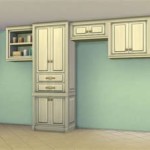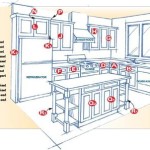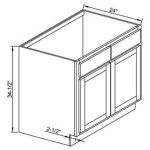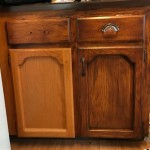Grease Cutting Cleaner For Kitchen Cabinets: A Comprehensive Guide
Kitchen cabinets, particularly those located near the stove, invariably accumulate grease, grime, and food splatters over time. This buildup not only detracts from the kitchen's aesthetic appeal but can also become a breeding ground for bacteria and mold. Therefore, regular and effective cleaning is essential to maintain both the hygiene and appearance of kitchen cabinets. The selection of an appropriate grease-cutting cleaner is critical to achieving optimal results without damaging the cabinet's finish.
This article provides a comprehensive overview of grease-cutting cleaners suitable for kitchen cabinets, examining different types of cleaners, application methods, and important considerations for various cabinet materials and finishes. The aim is to equip homeowners with the knowledge necessary to select and utilize the most effective and safe cleaning solutions for their kitchen cabinets.
Understanding the Nature of Grease and Grime
Grease, in the context of kitchen environments, is typically composed of fats and oils released during cooking. These substances often become airborne and settle on surfaces like kitchen cabinets. Over time, these fats and oils oxidize and polymerize, forming a sticky, tenacious layer that attracts dust, dirt, and food particles. This combination of grease, grime, and other contaminants creates a difficult-to-remove coating that requires specialized cleaning agents.
Traditional household cleaners may not be effective in breaking down the complex molecular structure of baked-on grease. Therefore, grease-cutting cleaners are formulated with specific ingredients, such as solvents, surfactants, and alkaline agents, designed to penetrate and dissolve the grease layer. Understanding the composition and properties of grease is crucial for choosing the right cleaning solution.
Furthermore, the type of cooking habits and the ventilation system within the kitchen significantly impact the rate and degree of grease accumulation. Homes with frequent frying or sautéing will experience a higher grease buildup compared to those with primarily boiling or baking activities. An inadequate ventilation system will exacerbate the problem by allowing grease particles to circulate and settle more readily on surfaces.
Types of Grease-Cutting Cleaners for Kitchen Cabinets
A vast array of grease-cutting cleaners is available in the market, each with its own formulation, strengths, and weaknesses. These cleaners can be broadly categorized into several types, including all-purpose cleaners, degreasers, dish soaps, and natural cleaning solutions.
All-purpose cleaners are versatile solutions designed to clean a wide range of surfaces. While they may offer some grease-cutting capabilities, they may not be as effective on heavy or baked-on grease as specialized degreasers. It is important to select all-purpose cleaners that are specifically formulated for kitchen use and are safe for the cabinet's finish.
Degreasers are specifically formulated to dissolve grease and grime. These cleaners typically contain stronger solvents and surfactants compared to all-purpose cleaners. Degreasers are highly effective on stubborn grease buildup but should be used with caution, as some formulations can be harsh and potentially damage certain cabinet finishes. It is crucial to test the cleaner in an inconspicuous area before applying it to the entire cabinet surface.
Dish soaps, particularly those marketed as grease-fighting, can be effective for cleaning kitchen cabinets. Dish soaps contain surfactants that help to emulsify grease and dirt, allowing them to be easily wiped away. Dish soap solutions are generally gentler than degreasers and are suitable for regular cleaning and maintenance.
Natural cleaning solutions, such as vinegar and baking soda, offer an environmentally friendly alternative to commercial cleaners. Vinegar's acidity helps to cut through grease, while baking soda acts as a mild abrasive to remove stubborn grime. These solutions are generally safe for most cabinet finishes but should still be tested in an inconspicuous area before widespread use.
Commercial kitchen cleaners are designed for heavy duty jobs. These cleansers can be quite harsh and require protective gear when using. They are a good option when there is extremely baked on grease, but care must be taken when using to not damage the cabinets.
It is essential to carefully read the product label and instructions before using any grease-cutting cleaner. The label will provide information on the cleaner's intended use, safety precautions, and application instructions. Choosing the right type of cleaner depends on the severity of the grease buildup and the type of cabinet finish.
Application Methods and Techniques
The effectiveness of a grease-cutting cleaner relies not only on the product itself but also on the application methods employed. Proper application techniques ensure that the cleaner is effectively distributed, allowed sufficient time to work, and thoroughly removed to prevent residue buildup.
Preparation: Before applying any cleaner, it is important to prepare the area by removing loose debris and dust. This can be accomplished by wiping down the cabinets with a dry cloth or using a vacuum cleaner with a brush attachment. Protecting the surrounding surfaces, such as countertops and floors, with drop cloths or plastic sheeting is also recommended.
Application: The cleaner should be applied evenly to the cabinet surface. For spray cleaners, hold the bottle approximately 6-8 inches away from the cabinet and spray a light, even coat. For liquid cleaners, apply the solution to a clean cloth or sponge and gently wipe the cabinet surface. Avoid oversaturating the wood.
Dwelling Time: Allowing the cleaner sufficient dwelling time is crucial for it to penetrate and dissolve the grease. The recommended dwelling time will vary depending on the cleaner's formulation and the severity of the grease buildup. Refer to the product label for specific instructions. Generally, allowing the cleaner to dwell for 5-10 minutes is sufficient for light to moderate grease buildup.
Agitation: For stubborn grease stains, gentle agitation with a soft-bristled brush or sponge can help to loosen the grease and grime. Avoid using abrasive scrub pads or harsh brushes, as they can scratch or damage the cabinet finish.
Rinsing: After the dwelling time, thoroughly rinse the cabinet surface with clean water. Use a clean cloth or sponge to wipe away any remaining cleaner residue. It is important to remove all traces of the cleaner to prevent streaking or discoloration.
Drying: Once the cabinets have been rinsed, dry them thoroughly with a clean, dry cloth. This will help to prevent water spots and streaks.
Polishing (Optional): To enhance the shine and protect the cabinet finish, a furniture polish or wax can be applied after cleaning and drying. Choose a polish or wax that is specifically designed for the type of cabinet finish.
The method chosen will be dictated by the cleaner used. Always read the directions and follow them carefully.
Considerations for Different Cabinet Materials and Finishes
Kitchen cabinets are constructed from a variety of materials, including wood, laminate, metal, and thermofoil. Each material has unique properties and requires specific cleaning considerations to prevent damage and maintain its appearance. Additionally, the finish applied to the cabinet, such as paint, stain, or varnish, can also affect the choice of cleaning products and methods.
Wood Cabinets: Wood cabinets are susceptible to water damage and should be cleaned with care. Avoid oversaturating the wood with cleaner, as this can cause warping or swelling. Use a damp cloth to apply the cleaner and dry the cabinets thoroughly after rinsing. For painted wood cabinets, use a gentle, pH-neutral cleaner to prevent discoloration or damage to the paint.
Laminate Cabinets: Laminate cabinets are generally more resistant to water damage than wood cabinets. However, it is still important to avoid oversaturation and to dry the cabinets thoroughly after cleaning. Use a non-abrasive cleaner to prevent scratching the laminate surface.
Metal Cabinets: Metal cabinets are durable and easy to clean. However, some metal cleaners can be corrosive and should be avoided. Use a mild dish soap solution or a cleaner specifically designed for metal surfaces. Dry the cabinets thoroughly after cleaning to prevent rust.
Thermofoil Cabinets: Thermofoil cabinets are covered with a thin layer of vinyl. Avoid using harsh chemicals or abrasive cleaners, as they can damage the vinyl coating. Use a gentle, pH-neutral cleaner and a soft cloth to clean thermofoil cabinets.
Painted Cabinets: Painted cabinets can be delicate and require gentle cleaning. Avoid using harsh chemicals or abrasive cleaners, as they can damage the paint. Use a gentle, pH-neutral cleaner and a soft cloth to clean painted cabinets. Regularly check for chipped or peeling paint and touch up as needed to prevent further damage.
Stained Cabinets: Stained cabinets are generally more durable than painted cabinets. However, it is still important to use a gentle cleaner that will not strip the stain. Use a cleaner specifically designed for wood surfaces and follow the manufacturer's instructions carefully.
Always test any new cleaner in an inconspicuous area before applying it to the entire cabinet surface. This will help to identify any potential damage or discoloration.
Safety Precautions and Best Practices
When using grease-cutting cleaners, it is essential to follow safety precautions and best practices to protect oneself and the environment. Many commercial cleaners contain chemicals that can be harmful if inhaled, ingested, or come into contact with skin.
Ventilation: Always work in a well-ventilated area to avoid inhaling fumes. Open windows or use a fan to circulate air.
Protective Gear: Wear gloves to protect skin from contact with the cleaner. Eye protection, such as goggles or safety glasses, is also recommended to prevent splashes.
Storage: Store cleaners in a safe place, out of reach of children and pets. Keep cleaners in their original containers and properly seal them after use.
Disposal: Dispose of empty cleaner containers and unused cleaner solutions according to local regulations. Do not pour cleaners down the drain, as this can contaminate waterways.
Mixing Cleaners: Never mix different types of cleaners, as this can create dangerous chemical reactions. For example, mixing bleach with ammonia can produce toxic fumes.
Flammability: Be aware of the flammability of certain cleaners. Keep cleaners away from open flames or heat sources.
Manufacturer Instructions: Always follow the manufacturer's instructions for using and storing cleaners.
By adhering to these safety precautions and best practices, homeowners can minimize the risks associated with using grease-cutting cleaners and ensure a safe and effective cleaning experience.

How To Clean Sticky Grease Off Kitchen Cabinets Ovenclean

How To Remove Grease From Kitchen Cabinets 3 Methods Bob Vila
:max_bytes(150000):strip_icc()/ways-to-clean-wood-kitchen-cabinets-3017289-01-765f893e7cca49a1ab72d7c49efdf518.jpg?strip=all)
Tips For Cleaning Food Grease From Wood Cabinets

5 Tips On How To Clean Grease Off Kitchen Cabinets Tlc Cleaning

My 6 Top Picks For Degreasing Kitchen Cabinets Before Painting
:max_bytes(150000):strip_icc()/ways-to-clean-wood-kitchen-cabinets-3017289-00-fb8e5ae9eb004ec6b968f9d53e74cd1e.jpg?strip=all)
Tips For Cleaning Food Grease From Wood Cabinets
What Is The Most Effective Way To Clean Grease Off Laminated Kitchen Cabinets Quora
What Is The Most Effective Way To Clean Grease Off Laminated Kitchen Cabinets Quora

3 Ways To Clean Greasy Kitchen Cabinets Wikihow

How To Clean Grease From Kitchen Cabinets Trends Wood Finishing
Related Posts








